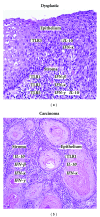Toll-like receptor transcriptome in the HPV-positive cervical cancer microenvironment
- PMID: 22013487
- PMCID: PMC3195758
- DOI: 10.1155/2012/785825
Toll-like receptor transcriptome in the HPV-positive cervical cancer microenvironment
Abstract
The human papillomavirus (HPV) directly infects cervical keratinocytes and interferes with TLR signalling. To shed light on the effect of HPV on upstream receptors, we evaluated TLRs 1-9 gene expression in HPV-negative normal and HPV-positive pre-malignant and malignant ex vivo cervical tissue. Quantitative real-time polymerase chain reaction was performed separately for epithelial and stromal tissue compartments. Differences in gene expression were analyzed by the Jonckheere-Terpstra trend test or the Student's t-test for pairwise comparison. Laser capture microdissection revealed an increase in TLR3 and a decrease in TLR1 mRNA levels in dysplastic and carcinoma epithelium, respectively. In the stroma, a trend of increasing TLR 1, 2, 5, 6, and 9 mRNA levels with disease severity was found. These findings implicate the involvement of TLR3 and TLR1 in early and late cervical carcinogenesis, respectively, suggesting that stromal upregulation of TLRs may play a role in cervical disease progression.
Figures


Similar articles
-
Expression of integrins and Toll-like receptors in cervical cancer: effect of infectious agents.Innate Immun. 2012 Feb;18(1):55-69. doi: 10.1177/1753425910392934. Epub 2011 Jan 14. Innate Immun. 2012. PMID: 21239458
-
IFN-κ, a novel type I IFN, is undetectable in HPV-positive human cervical keratinocytes.Lab Invest. 2010 Oct;90(10):1482-91. doi: 10.1038/labinvest.2010.95. Epub 2010 May 17. Lab Invest. 2010. PMID: 20479716
-
Association between toll-like receptor expression and human papillomavirus type 16 persistence.Int J Cancer. 2011 Feb 15;128(4):879-86. doi: 10.1002/ijc.25400. Int J Cancer. 2011. PMID: 20473890 Free PMC article.
-
Role of toll-like receptors in cervical, endometrial and ovarian cancers: a review.Gynecol Oncol. 2014 Nov;135(2):359-63. doi: 10.1016/j.ygyno.2014.08.013. Epub 2014 Aug 16. Gynecol Oncol. 2014. PMID: 25135000 Review.
-
[Role of Toll-like receptors in persistent infection of cervical high-risk human papillomavirus based on "latent pathogen theory"].Zhongguo Zhong Yao Za Zhi. 2025 Apr;50(7):1974-1979. doi: 10.19540/j.cnki.cjcmm.20250109.501. Zhongguo Zhong Yao Za Zhi. 2025. PMID: 40350890 Review. Chinese.
Cited by
-
Involvement of Toll-like Receptor 9 polymorphism in cervical cancer development.Mol Biol Rep. 2012 Aug;39(8):8425-30. doi: 10.1007/s11033-012-1695-8. Epub 2012 Jun 20. Mol Biol Rep. 2012. PMID: 22714906 Free PMC article.
-
The role of TLRs in cervical cancer with HPV infection: a review.Signal Transduct Target Ther. 2017 Nov 3;2:17055. doi: 10.1038/sigtrans.2017.55. eCollection 2017. Signal Transduct Target Ther. 2017. PMID: 29263932 Free PMC article. Review.
-
Immuno-related polymorphisms and cervical cancer risk: The IARC multicentric case-control study.PLoS One. 2017 May 15;12(5):e0177775. doi: 10.1371/journal.pone.0177775. eCollection 2017. PLoS One. 2017. PMID: 28505207 Free PMC article.
-
Epidemiology, Molecular Pathogenesis, Immuno-Pathogenesis, Immune Escape Mechanisms and Vaccine Evaluation for HPV-Associated Carcinogenesis.Pathogens. 2023 Nov 23;12(12):1380. doi: 10.3390/pathogens12121380. Pathogens. 2023. PMID: 38133265 Free PMC article. Review.
-
Expression of toll-like receptors in HPV-positive and HPV-negative oropharyngeal squamous cell carcinoma--an in vivo and in vitro study.Tumour Biol. 2015 Sep;36(10):7755-64. doi: 10.1007/s13277-015-3494-z. Epub 2015 May 5. Tumour Biol. 2015. PMID: 25941114
References
-
- Akira S, Takeda K. Toll-like receptor signalling. Nature Reviews Immunology. 2004;4(7):499–511. - PubMed
-
- Isaacs A, Lindenmann J. Virus interference. I. The interferon. Proceedings of the Royal Society of London. Series B. 1957;147(927):258–267. - PubMed
-
- Takaoka A, Hayakawa S, Yanai H, et al. Integration of interferon-α/β signalling to p53 responses in tumour suppression and antiviral defence. Nature. 2003;424(6948):516–523. - PubMed
-
- Stetson DB, Medzhitov R. Type I Interferons in Host Defense. Immunity. 2006;25(3):373–381. - PubMed

